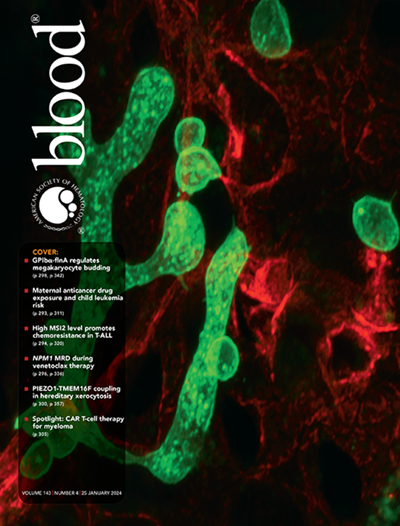一项2期随机研究:莫达卡usp作为单一药物治疗复发/难治性多发性骨髓瘤。
IF 21
1区 医学
Q1 HEMATOLOGY
引用次数: 0
摘要
Modakafusp是一种一流的免疫细胞因子,可将干扰素-α引导至cd38阳性细胞。我们之前的1/2期试验确定了复发/难治性多发性骨髓瘤(RRMM)患者的两种潜在2期剂量:每4周1.5或3mg /kg (Q4W)。在接受1.5 mg/kg剂量治疗的30例患者中,总缓解率(ORR)为43%。这项2期剂量优化研究(NCT03215030)随机分配147例三级难治性疾病患者,既往治疗≥3条线,以1:1的剂量给予莫达卡usp 120mg (n = 71)或240mg (n = 75) Q4W(固定剂量相当于1.5和3mg /kg Q4W)。患者先前接受的治疗中位数为6个疗程;五元暴露者66%,抗bcma暴露者45%。由于战略原因,赞助商停止了Modakafusp α的开发,研究提前终止。在120和240 mg组中位随访7.3和7.6个月时,orr分别为32%和41%;中位无进展生存期分别为4.1个月和5.3个月。先前未接受bcma治疗的患者orr更高(46% vs 29%)。120和240 mg组中最常见的治疗相关不良事件(teae)是血小板减少症(75%和84%;≥3级,55%和61%)和中性粒细胞减少症(68%和73%;等级≥3、56%和68%);90%和96%的患者经历≥3级teae;39%和44%经历过严重的teae。药代动力学研究表明,240毫克比120毫克的剂量高2倍。我们的研究结果证实了单药莫达卡福素对RRMM患者的疗效。本文章由计算机程序翻译,如有差异,请以英文原文为准。
A phase 2 randomized study of modakafusp alfa as a single agent in patients with relapsed/refractory multiple myeloma.
Modakafusp alfa is a first-in-class immunocytokine directing interferon-α to CD38-positive cells. Our previous phase 1/2 trial identified two potential phase 2 doses of modakafusp alfa in patients with relapsed/refractory multiple myeloma (RRMM): 1.5 or 3 mg/kg every 4 weeks (Q4W). The overall response rate (ORR) among 30 patients treated at 1.5 mg/kg was 43%. This phase 2 dose optimization study (NCT03215030) randomized 147 patients with triple-class refractory disease and ≥3 prior lines of therapy 1:1 to modakafusp alfa 120 mg (n = 71) or 240 mg (n = 75) Q4W (fixed-dose equivalents of 1.5 and 3 mg/kg Q4W). Patients had received a median of 6 prior lines of therapy; 66% were penta-exposed and 45% anti-BCMA-exposed. Modakafusp alfa development was discontinued for strategic reasons by the sponsor and the study was terminated early. At median follow-ups of 7.3 and 7.6 months in the 120 and 240 mg arms, ORRs were 32% and 41%; median progression-free survival was 4.1 and 5.3 months, respectively. ORRs were higher in patients who had not received prior-BCMA therapy (46% vs 29%). The most common treatment-related adverse events (TEAEs) in the 120 and 240 mg arms were thrombocytopenia (75% and 84%; grade ≥3, 55% and 61%) and neutropenia (68% and 73%; grade ≥3, 56% and 68%); 90% and 96% of patients experienced grade ≥3 TEAEs; 39% and 44% experienced serious TEAEs. Pharmacokinetic studies showed a ~2-fold greater exposure with 240 vs 120 mg. Our results confirm the efficacy of single-agent modakafusp alfa in patients with RRMM.
求助全文
通过发布文献求助,成功后即可免费获取论文全文。
去求助
来源期刊

Blood
医学-血液学
CiteScore
23.60
自引率
3.90%
发文量
955
审稿时长
1 months
期刊介绍:
Blood, the official journal of the American Society of Hematology, published online and in print, provides an international forum for the publication of original articles describing basic laboratory, translational, and clinical investigations in hematology. Primary research articles will be published under the following scientific categories: Clinical Trials and Observations; Gene Therapy; Hematopoiesis and Stem Cells; Immunobiology and Immunotherapy scope; Myeloid Neoplasia; Lymphoid Neoplasia; Phagocytes, Granulocytes and Myelopoiesis; Platelets and Thrombopoiesis; Red Cells, Iron and Erythropoiesis; Thrombosis and Hemostasis; Transfusion Medicine; Transplantation; and Vascular Biology. Papers can be listed under more than one category as appropriate.
 求助内容:
求助内容: 应助结果提醒方式:
应助结果提醒方式:


